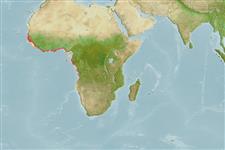Environment: milieu / climate zone / depth range / distribution range
Ekologi
laut; air tawar; payau; kisaran kedalaman 1 - 50 m (Ref. 26999). Tropical; 21°N - 29°S, 20°W - 15°E
Eastern Atlantic: coastal waters of West Africa from Mauritania to Angola or Namibia (Ref. 4445, 81265, 81629). Sometimes it enters freshwater, like in Cross River and Kouilou-Niari River (Ref. 81629). It is often confused with Elops senegalensis (Ref. 81629).
Size / Weight / umur
Maturity: Lm ? range ? - ? cm
Max length : 100.0 cm TL jantan/; (Ref. 5377); common length : 60.0 cm TL jantan/; (Ref. 2683)
Duri punggung (Keseluruhan (total)): 0; Duri dubur 0. Diagnosis: Elops lacerta is characterized by 17-19 gill-rakers on lower limb of first gill arch and small scales, those in lateral line numbering 72 to 83 and ornamented with a small, unbranched, tubule (Ref. 2844, 81265, 81629).
Elops lacerta lives in shallow coastal waters over sandy/muddy bottoms, occasionally entering brackish waters and the lower reaches of rivers; from inshore and some way up tidal rivers to edge of shelf (Ref. 4445, 81265, 81629). The reproduction takes place in the sea (Ref. 81265). It feeds primarily on small fishes, mainly clupeids, crustaceans and molluscs; large specimens also feed on insects (Ref. 81629).
Life cycle and mating behavior
Kematangan | Reproduksi, perkembang biakan | Pemijahan | telur-telur | Fecundity | Larva
Whitehead, P.J.P., 1990. Elopidae. p. 118-119. In J.C. Quero, J.C. Hureau, C. Karrer, A. Post and L. Saldanha (eds.) Check-list of the fishes of the eastern tropical Atlantic (CLOFETA). JNICT, Lisbon; SEI, Paris; and UNESCO, Paris. Vol. 1. (Ref. 4445)
Status IUCN Red List (Ref. 130435)
ancaman kepada manusia
Harmless
penggunaan manusia
Perikanan: komersial; Ikan buruan: ya
informasi lanjut
Nama-nama umumSinonim (persamaan)metabolismePemangsaEkotoksikologiReproduksi, perkembang biakanKematanganPemijahanSpawning aggregationFecunditytelur-telurpekembangan telor
AcuanBudidaya airprofil budidaya airStrainGenetikaElectrophoresesDiturunkanPenyakit-penyakitPengolahanNutrientsMass conversion
mitraGambarStamps, Coins Misc.Suara-suaraCiguateraKecepatanTipe renangArea insangOtolithsOtakPenglihatan / visi
Alat, peralatan
laporan khas
muat turun XML
Sumber internet
Estimates based on models
Preferred temperature (Ref.
123201): 23.8 - 28, mean 26.7 °C (based on 68 cells).
Phylogenetic diversity index (Ref.
82804): PD
50 = 0.5176 [Uniqueness, from 0.5 = low to 2.0 = high].
Bayesian length-weight: a=0.00646 (0.00487 - 0.00855), b=2.97 (2.89 - 3.05), in cm total length, based on LWR estimates for this species (Ref.
93245).
Trophic level (Ref.
69278): 4.2 ±0.75 se; based on food items.
Generation time: 1.5 ( na - na) years. Estimated as median ln(3)/K based on 1
growth studies.
Daya lenting (Ref.
120179): sedang, Waktu penggandaan populasi minimum 1.4 - 4.4 tahun (Assuming tm=2-3; K=0.7 for juveniles).
Prior r = 0.57, 95% CL = 0.37 - 0.85, Based on 1 stock assessment.
Fishing Vulnerability (Ref.
59153): Low to moderate vulnerability (32 of 100).
Climate Vulnerability (Ref.
125649): Very high vulnerability (83 of 100).
Nutrients (Ref.
124155): Calcium = 100 [59, 207] mg/100g; Iron = 1.23 [0.71, 2.15] mg/100g; Protein = 17.2 [14.7, 20.3] %; Omega3 = 0.197 [0.105, 0.378] g/100g; Selenium = 63.3 [29.7, 146.8] μg/100g; VitaminA = 8.36 [3.04, 23.05] μg/100g; Zinc = 0.981 [0.695, 1.430] mg/100g (wet weight);
